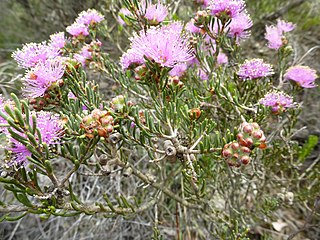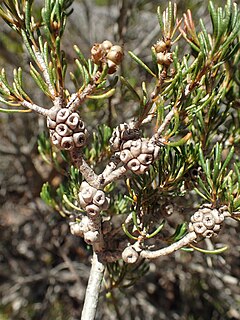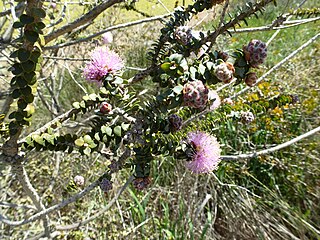Melaleuca penicula is a plant in the myrtle family, Myrtaceae and is endemic to the south of Western Australia. It is a rare species only known from the Fitzgerald River National Park and resembles Melaleuca eximia with its spikes of red flowers but its leaves and stamen bundles are different.

Melaleuca amydra is a plant in the myrtle family, Myrtaceae and is endemic to the south-west of Western Australia. It is similar to Melaleuca ryeae with its small, compact form, oval leaves and "pom-pom" heads of pink to purple flower heads on the ends of the branches in spring.

Melaleuca barlowii is a plant in the myrtle family, Myrtaceae and is endemic to the south-west of Western Australia. It is similar to a number of other Western Australian melaleucas such as M. conothamnoides with its purple pom-pom flower heads but is a more erect shrub with different leaves and the fruiting clusters have a different shape.
Melaleuca boeophylla is a plant in the myrtle family, Myrtaceae and is endemic to the south-west of Western Australia. It is similar to a number of other Western Australian melaleucas such as M. filifolia with its purple pom-pom flower heads but its leaves are shorter and oval in cross-section.

Melaleuca campanae is a plant in the myrtle family, Myrtaceae and is endemic to the south-west of Western Australia. It is a small, woody shrub similar to Melaleuca eulobata, with a low, spreading habit and pinkish flower heads but it has longer, pointed leaves and lacks distinct sepals which instead form a ring of tissue around the edge of the flowers.

Melaleuca carrii is a plant in the myrtle family, Myrtaceae and is endemic to the south-west of Western Australia. It is a small shrub similar to Melaleuca pentagona, with "pom-pom" heads of pinkish flowers and sharply pointed leaves but it is generally smaller, lacks a groove in its leaves and retains its petals on the flowers for longer than that species.

Melaleuca clavifolia is a plant in the myrtle family, Myrtaceae and is endemic to the south-west of Western Australia. It is a small shrub similar to Melaleuca tinkeri, with "pom-pom" heads of pinkish flowers and soft, silky hairs on the new growth but it has larger flower heads and its leaves are shorter, more club-shaped and have less distinct oil glands.

Melaleuca calyptroides is a plant in the myrtle family, Myrtaceae and is endemic to the south-west of Western Australia. It is similar to a number of other Western Australian melaleucas such as M. hollidayi with its almost cylindrical leaves, purple pom-pom flower heads and low growth habit but it has longer, wartier leaves and fewer flowers in the inflorescences. The floral cup and woody capsule from which it develops are longer than those of similar melaleucas.
Melaleuca eulobata is a plant in the myrtle family, Myrtaceae and is endemic to the west coast of Western Australia. It is a shrub resembling Melaleuca campanae with its heads of pink flowers in late spring but is distinguished from that species by its sepals - in M. campane these are reduced to a ring of tissue but M. eulobata has distinct calyx lobes.

Melaleuca leuropoma is a plant in the myrtle family, Myrtaceae and is endemic to the south-west of Western Australia. It is a small to medium-sized shrub which flowers over an extended period with flower colour varying from purple to yellow or white. The glossy, often brown petals covering the flower buds are also an unusual characteristic of this species.

Melaleuca orbicularis is a plant in the myrtle family, Myrtaceae and is endemic to the south-west of Western Australia. It is similar to Melaleuca cordata with its pinkish "pom-pom" heads of flowers but its leaves are smaller, almost circular compared to the heart shaped leaves of the other species.

Melaleuca osullivanii is a plant in the myrtle family, Myrtaceae and is endemic to the south-west of Western Australia. It was first formally described in 2004 after a review of the broombush group, Melaleuca uncinata. It differs from others in the group by having leaves that are fine and circular in cross section. The closest other broombrush is Melaleuca hamata whose leaves are 0.8–1.6 mm (0.03–0.06 in) in diameter compared to 0.7–0.9 mm (0.03–0.04 in) for this species.
Melaleuca similis is a plant in the myrtle family, Myrtaceae and is endemic to the south west of Western Australia. It is a small shrub, similar to Melaleuca stramentosa with its narrow, almost cylindrical leaves and heads of pink to purple flowers but lacks the matted, silky hairs on the young leaves and outer edge of the flower cup.

Melaleuca societatis is a plant in the myrtle family, Myrtaceae and is endemic to the south west of Western Australia. It is a dwarf shrub with small, fleshy leaves and many heads of pink or purple flowers in spring, followed by "soccer-ball" fruit.
Melaleuca stramentosa is a plant in the myrtle family, Myrtaceae and is endemic to the south-west of Western Australia. It is a small, bushy shrub similar to Melaleuca similis with its cylindrical leaves and heads of pink to purple flowers but differs in have matted, woolly hairs around the flowers and on the young leaves.

Melaleuca marginata is a shrub in the myrtle family, Myrtaceae and is endemic to the south-west of Western Australia. It is distinguished by its prickly leaves and its flowers occurring in long sections of the branches. From 1922 to 2011 was known as Melaleuca coronicarpa.

Melaleuca dichroma is a shrub in the myrtle family, Myrtaceae and is endemic to the south-west of Western Australia. It is unusual for its genus in that its flowers are yellow or creamy-white but age to a pinkish-red.

Melaleuca acutifolia is a plant in the myrtle family, Myrtaceae and is endemic to the south-west of Western Australia. It has small, pointed, oval leaves and in summer, heads of white flowers. The species was originally described as a variety of Melaleuca lateriflora but was raised to species status in 2010.

Melaleuca spectabilis is a plant in the myrtle family, Myrtaceae, and is endemic to the south-west of Western Australia. It was formerly known as a subspecies of Melaleuca longistaminea. It is a low, prickly shrub with yellow or lime-green flowers in spring and early summer.

Melaleuca ulicoides is a plant in the myrtle family, Myrtaceae and is endemic to the south of Western Australia. It is a small, densely foliaged shrub with small heads of white or cream flowers in spring. It is closely related to Melaleuca marginata but can be distinguished from it by the number and character of leaf veins.

















